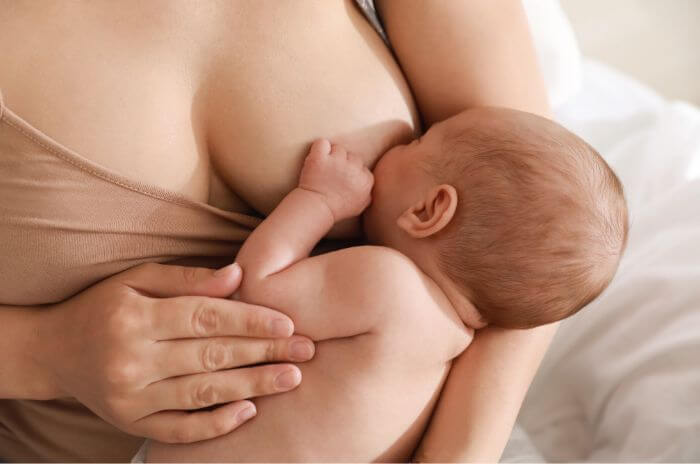
Congratulations, you've given birth! Now what? Pregnancy is often defined as three trimesters, but there is a lesser-known fourth trimester that can be just as essential to the journey as parents and babies adjust to their new lives together.
What is the Fourth Trimester?
The fourth trimester refers to the immediate months following the birth of your baby that can often be as confusing and overwhelming as they are exciting and full of love. It’s a time of intense connection as you all get to know each other but can also signal a period of significant physical and emotional changes for both mothers and babies.
After all, your baby is adjusting to life outside of the womb and you’re navigating recovery and hormonal swings whilst simultaneously learning the ropes of motherhood! Naturally, the focus shifts towards the baby’s needs after birth, leading to the neglect of what a freshly postpartum mother requires.
With a little help, this period of transition can be manageable, memorable and precious. Here is our guide to fourth-trimester care and our best tips for surviving it!
What’s Going on with Your Body?
Woah, mama! Your newborn is adjusting to the sights, sounds and feelings of a whole new world outside the womb which can present as fussiness and bouts of crying. You’re tired, your days are sporadic tending to what your baby needs and your self-care as you recover and heal has taken a back seat as you feel your way through this tricky period.
Being prepared and understanding that looking after yourself is a part of looking after your baby is essential to supporting both of you through these major transformations.

The Hormonal Rollercoaster
Your postnatal body is working to recalibrate your hormones leading to fluctuating moods and emotions and wreaking havoc on your skin and hair.
Did you notice your hair was extra thick and luscious during pregnancy? That’s because pregnancy hormones prevent you from shedding! Postpartum hair loss (whilst alarming) is actually just a shedding of all the hair you held onto during pregnancy - so don’t freak out, you’re not going bald! Try a few of these to support the fallout of follicles:
- Try to maintain a balanced diet
- Avoid tight ponytails or hairstyles that pull at your scalp
- Be extra gentle while brushing, washing and styling
- Massage your scalp to promote circulation to the follicles
Patchy, dry skin can also be problematic during the early postpartum days. The dramatic decline in estrogen and progesterone after giving birth can contribute to dry skin along with increased demands on your body's water supply if you're breastfeeding. Be sure to:
- Nourish your skin with a rich oil or moisturiser
- Drink plenty of water to support breastfeeding along with skin hydration from the inside
- Avoid harsh soaps and chemicals
Producing darkened skin around the forehead, cheeks, nose or lips has earned Melasma the title of the “mask of pregnancy”. Caused by hyperpigmentation when estrogen levels lead to an overproduction of melanin, Melasma is experienced to some degree by around 50 - 70% of people during pregnancy making it a common but pesky condition. Whilst Melasma fades over time as your hormones level out, preventative measures can help keep it at bay including:
- Wear sunscreen
- Cover up with a light layer of clothing even in summer
- Seek shade - Limit sunbathing and try relaxing under a tree or umbrella instead
- Avoid peak sun hours in your area, and head out early in the morning or later in the evening when the sun is not at its strongest
A combination of the passage of time and self-care is the best remedy for these common conditions. If you’re finding any of these conditions persistent, speak with your doctor about options for treatment and the benefits and risks of each. You’ll be glowing again before you know it!

Keeping Abreast of Changes
Milk ahoy! Just a few days after birth, breast milk production ramps up as your levels of prolactin (a breastfeeding-related hormone) increase. It’s completely normal for your breasts to feel sore or tender as milk comes in, transitioning from colostrum (the first secretion from mammary glands) to transitional milk and finally mature milk. Pretty cool, what breasts can do!
During this time, breast engorgement can create discomfort in breastfeeding individuals but typically decreases throughout the first six weeks as your body learns your baby’s feeding habits and requirements, and adapts accordingly to create a steady milk supply. Here’s how to support your breasts (literally and figuratively):
- Choose a comfortable but supportive nursing bra
- Have your favourite nipple balm or cream on hand to lather on cracked, sore nipples
- Gently release blocked milk ducts by massaging towards the nipple in a warm bath or shower, or applying a warm (not hot) compress

Rest & Recover
The way women feel in their postnatal bodies can be empowering and also challenging as social media can set unrealistic expectations of ‘bouncing back’ after birth. Remember, your body has remarkably just given life to another!
Organs are shifting back into place, your posture may have changed to accommodate your growing bump, and depending on what kind of birth you had, you may be recovering from surgery or finding a lingering weakness in your pelvic floor & abdominals.
Whilst it’s all worthwhile - you finally have your baby in your arms after all - and most of it temporary, it can make an enormous difference to hydrate and rest during these early days. Here are a few of our favourite tips to support your physical recovery:
Put your feet up as much as possible! Let go of the expectations that you need to welcome a constant stream of visitors, rush around for coffee with friends or hit the gym as soon as you can.
Self-massage. Create space for you to care for yourself by carving out a few minutes each day for self-massage and choose an oil with soothing properties and a comforting scent. It can not only help you reconnect with your body that has been through so much, but it can also help with blood flow to aid in healing, swelling reduction and soothing tired or sore muscles. Pay particular attention to any areas that may have experienced trauma such as the perineum and the abdominal area
Ask for help. The fourth trimester can feel incredibly vulnerable as a new mama. Naturally, people will offer to help and it’s tempting to try and do everything yourself. Remember, you too deserve to be honoured, held, and nourished as you heal and transition to being a parent.
Seek support. After-birth compression clothing and shapewear can help expedite the recovery process whilst providing much-needed support and alleviating pressure while your body heals from either a vaginal or c-section birth.
Soak it up. A warm (not hot) bath with postpartum bath salts can help ease cramps and muscular aches and pains associated with pregnancy and childbirth

What’s Happening for Your Baby?
Needless to say, your baby is adjusting to some major changes moving from the familiarity, warmth, darkness and the quiet comfort of the womb to the bright, sometimes cold and noisy world and can quickly become overstimulated and overwhelmed. By knowing what to expect from your baby, you can offer plenty of love and support in this period of exponential growth and development:
Overstimulation
The most obvious signal of overstimulation is crying but can also be joined by fussiness or irritability, not wanting to be held or comforted, feeding refusal, and clenched fists. If you suspect your baby might be overstimulated, reduce as many triggers as possible and try to calm them in a dimly lit, warm room.
Huge Physical Changes and Growth
Babies grow at different rates but on average may gain 600 - 900 grams in weight. As they start to realise they’re outside of the womb, their limbs will slowly extend and gain strength to move beyond the reflex responses into more deliberate movements. Those anxiety-inducing head wobbles will also start to decrease as their neck muscles strengthen to hold their heads.
Peek-a-boo!
Baby’s sight develops quickly in the first 3 months of life and you’ll find their unfocused gaze will start to fixate on objects and track your movements. In fact, by around 8 - 9 weeks old, their vision becomes almost as clear as an adult's! In response to their improving vision, you might find they engage with you more and heartwarmingly start to smile.
Nocturnal Tendencies
Irregular sleeping patterns are completely normal in the fourth trimester as your baby’s tiny stomach literally can’t fit enough milk to sustain long periods without feeding (hello, nighttime feeds!). Swaddling is a great way to help babies feel supported and comforted while they sleep.
Try to offer some consistency and predictability in your daily routine, and as your baby grows and settles into the rhythms of life they’ll fall into a more predictable sleeping and feeding pattern.

When Does the Fourth Trimester End?
The question on every new mum’s lips: does it get easier after the fourth trimester? The good news is, at around 12 weeks when the fourth trimester ends you’ll hopefully feel a little more settled and less overwhelmed being able to predict your baby’s needs.
The reality is, parenthood is a beautiful series of gradual transitions with each stage offering exciting and wonderful new developments, along with fresh challenges. You’ve got this, mama!
The Takeaway
Every mama’s postpartum experience is different and will also vary widely from baby to baby. First and foremost, we recommend giving yourself grace as you navigate the early days of recovery, prioritise rest, listen to your body and where needed invest in some good quality products to support your healing and recovery.
For all your fourth trimester needs, check out Queen Bee’s range of prenatal and postpartum support products for mother and baby.
